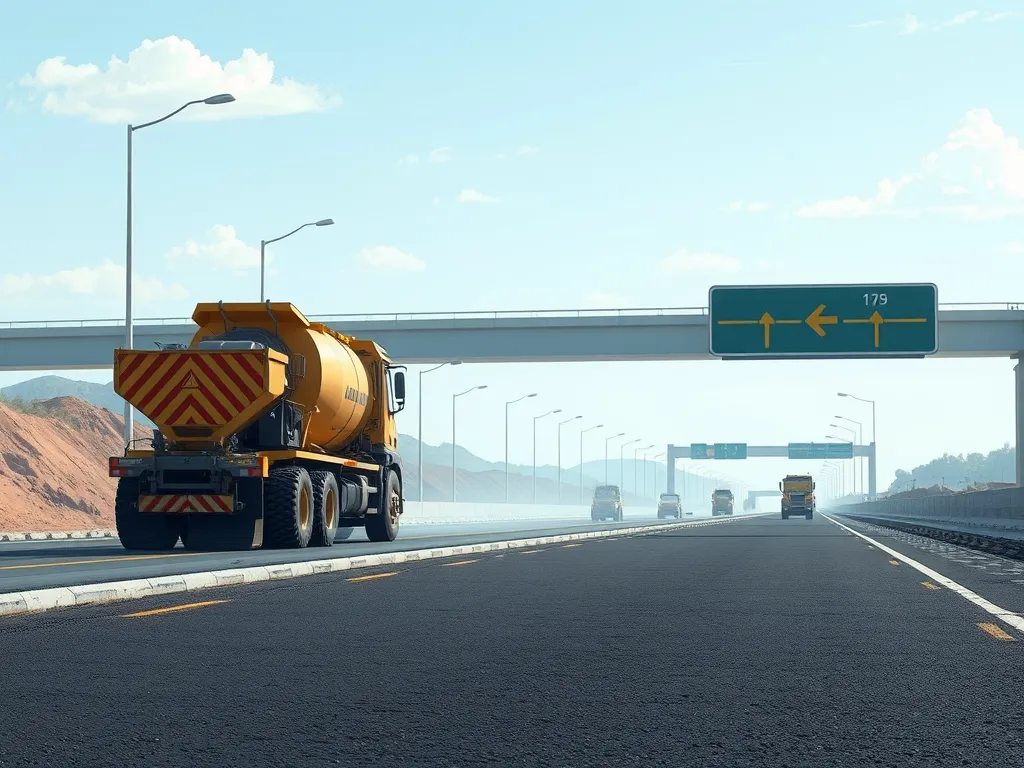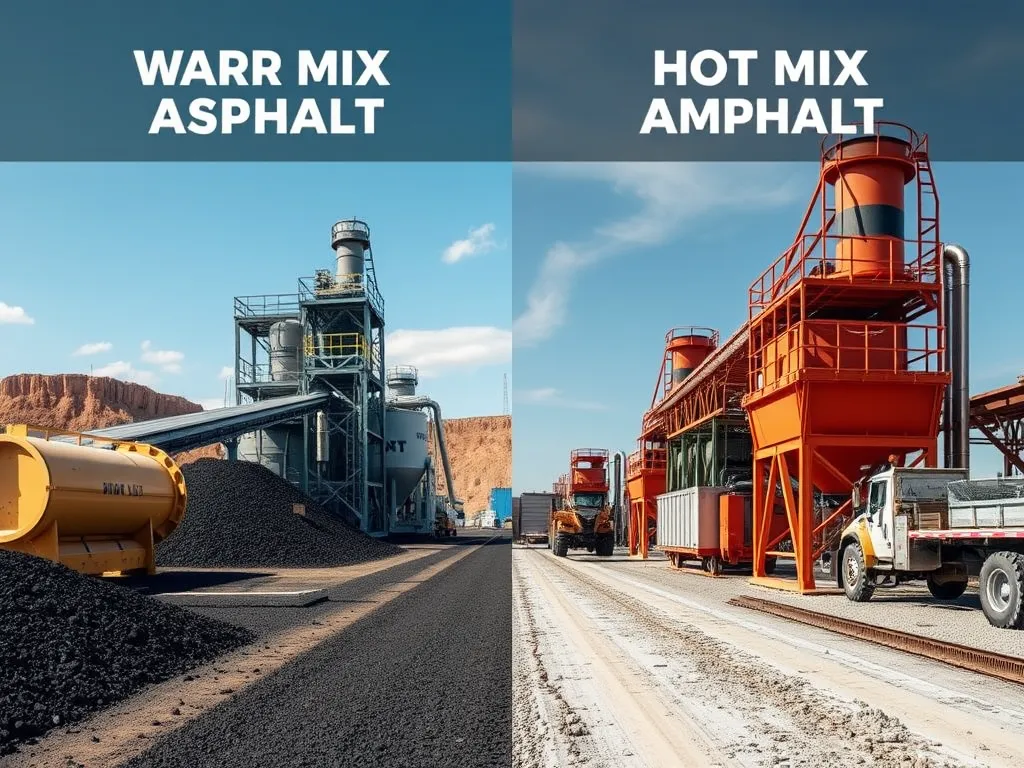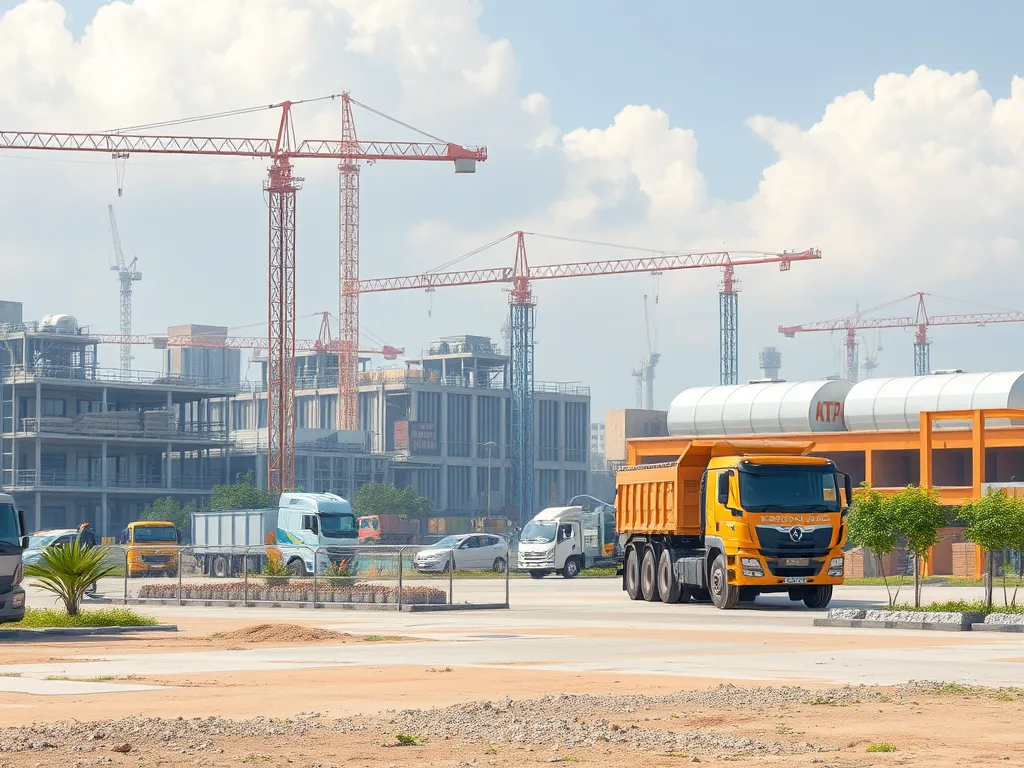Cost-effectiveness Of Warm Mix Asphalt: Cutting Costs Without Compromising Quality
Published on: November 8, 2025 | Last Updated: April 14, 2025
Written By: George Voss
Warm mix asphalt (WMA) costs 15-25% less than traditional hot mix asphalt (HMA) by lowering production temperatures from 302-338°F to 212-284°F using additives like zeolites or chemical surfactants. This temperature drop reduces fuel use by 20-35% at asphalt plants while maintaining durability through modified PG binders (performance-graded asphalt cement). Contractors save $3-$8 per ton on average through faster installation and extended paving seasons, even with initial additive costs of $1.50-$4 per ton.
This article breaks down how WMA achieves cost savings through energy efficiency, reduced labor hours, and lower emissions fines. You’ll find data on production expenses, comparisons with HMA pricing, and real-world projects showing 18% fuel reductions. We also cover environmental cost benefits like 30% fewer CO₂ emissions and tools to calculate your potential savings.
Contents
- Introduction to Warm Mix Asphalt Cost Analysis
- Advantages Of Warm Mix Asphalt
- Disadvantages Of Warm Mix Asphalt
- Cost-effectiveness Analysis Of Warm Mix Asphalt
- Warm Mix Vs Hot Mix Asphalt: Cost Comparison
- Case Studies: Real-world Cost Savings
- Environmental Benefits &Amp; Cost Implications
- Calculating Warm Mix Asphalt Costs
- FAQ: Warm Mix Asphalt Cost Questions
- Closing Thoughts
- Useful References for You:
Introduction to Warm Mix Asphalt Cost Analysis
Analyzing warm mix asphalt cost involves balancing upfront spending against long-term gains. This mix lowers production temps by 30-50°F compared to hot mix asphalt (HMA), changing how contractors budget for fuel, labor, and timelines. Agencies prioritizing warm mix asphalt cost benefit studies often find savings in multi-phase projects.
Defining Warm Mix Asphalt (WMA)
Warm mix asphalt combines aggregates with performance-graded (PG) binders at 212-284°F, using additives like waxes or liquid chemicals. Foaming methods inject water or organic agents to cut viscosity. This allows workability at lower temps while maintaining structural capacity.
Key Differences from Traditional Asphalt
| Factor | WMA | HMA |
|---|---|---|
| Production Temp | 212-284°F | 280-320°F |
| Fuel Use | 18-22 gal/hr | 24-28 gal/hr |
| Additives | Sasobit, Advera | None |
Lower temps trim fuel costs by 20% per ton. Additives add $2-$6 per ton but offset this with shorter haul times. PG binders in WMA require strict quality control, impacting warm mix asphalt pricing by up to 8% versus HMA.
With production basics clarified, the next segment shows how these technical shifts drive financial gains in real-world applications.
Advantages Of Warm Mix Asphalt
Warm mix asphalt delivers measurable cost benefits through three primary advantages. These factors work together to lower expenses while maintaining pavement performance.
Reduced Production Temperatures &Amp; Energy Savings
Warm mix asphalt requires production temperatures 50-100°F lower than traditional hot mix asphalt. Plants operate at 250-275°F instead of 300-350°F, cutting energy use by 20-35%. This temperature drop directly lowers burner fuel demands. A Texas Transportation Institute study found WMA reduces CO₂ emissions by 30% per ton produced—saving $1.50-$3.00 per ton in energy costs.
Lower Fuel Consumption During Mixing &Amp; Transport
The decreased heat requirement slashes fuel use at asphalt plants. Virginia DOT reported 15% less diesel consumption in WMA production compared to hot mix. Trucks hauling warm mix also burn less fuel—the material stays workable longer, eliminating need for reheating on-site. Projects can extend haul distances by up to 25% without compromising pavement quality.
Faster Paving &Amp; Compaction Times
Warm mix reaches optimal compaction density faster due to lower viscosity at placement temperatures. Crews complete paving 30% quicker on average, reducing labor hours and equipment rental fees. A Michigan highway project saved $18,000 in traffic control costs by finishing two days early. This accelerated timeline allows more work within tight weather windows.
While these operational efficiencies boost the cost-effectiveness of warm mix asphalt, project teams must also weigh technical and financial considerations that impact total expenses.

Disadvantages Of Warm Mix Asphalt
While warm mix asphalt offers clear cost benefits, certain challenges impact its financial viability. Contractors must weigh these factors against project goals and local conditions.
Initial Investment in Modified Equipment
Producing warm mix asphalt requires plant upgrades or specialized gear. Foaming systems for water-based WMA cost $50,000-$200,000 depending on production capacity. Chemical additive systems need precise metering pumps and storage tanks, adding $15,000-$40,000 to setup costs. These investments can delay ROI for smaller paving companies handling under 50,000 tons annually.
Potential Additive Costs
Organic waxes and chemical packages increase material expenses by $3-$8 per ton compared to hot mix asphalt. Sasobit® wax additives average $5.20/ton, while Evotherm® chemical solutions cost $7.50/ton. Projects requiring PG 76-22 performance-graded binders might need pricier modifiers, pushing warm mix asphalt pricing 4-9% above conventional mixes before accounting for fuel savings.
Performance Considerations in Extreme Conditions
Warm mix asphalt compacted below 230°F in cold climates shows 12% higher rutting risk according to NCAT studies. Projects in regions with sub-40°F winter temps often require thicker lifts or polymer-modified binders, adding $1.50-$4.00 per square yard. In high-traffic zones, lifespan projections drop 2-4 years without these adjustments, affecting long-term warm mix asphalt cost benefit calculations.
These factors highlight why detailed site analysis matters when evaluating warm mix asphalt cost effectiveness. Next, we break down actual savings through comparative tonnage pricing and operational efficiencies.
Also See: Community Benefits Of Sustainable Asphalt Roads
Cost-effectiveness Analysis Of Warm Mix Asphalt
Breaking down the financial case for warm mix asphalt (WMA) requires examining both short-term expenses and multi-year savings. Let’s cut through the noise with hard numbers.
Warm Mix Asphalt Cost Per Ton Vs Traditional Asphalt
WMA typically runs $2-$5 more per ton than hot mix asphalt (HMA) due to additives like zeolites or Sasobit. But raw material costs tell only half the story.
Price Comparison: Material & Labor
Contractors save $3-$7 per ton on labor with WMA. Lower mixing temperatures (250-275°F vs HMA’s 300-350°F) allow faster truck loading and longer hauls. A 10,000-ton project could net $15k in labor savings despite higher material costs.
Long-term Savings From Reduced Energy Use
Producing WMA slashes fuel consumption by 20-35% compared to HMA. For a plant burning 7 gallons of diesel per hour, switching to WMA saves 50+ gallons daily. Over a 150-day paving season, that’s 7,500 gallons saved – roughly $30,000 at current diesel prices.
Extended Paving Season &Amp; Project Efficiency
WMA’s lower laying temperature (185°F vs 280°F for HMA) adds 2-4 weeks to annual paving windows in northern states. Contractors report completing projects 25% faster due to improved workability. Nighttime paving in urban areas becomes viable, cutting traffic delay costs by $1,200-$2,500 per hour.
While initial warm mix asphalt pricing appears higher, these operational efficiencies create net savings. Next, we’ll compare production line items between WMA and HMA to pinpoint where dollars stack best.

Warm Mix Vs Hot Mix Asphalt: Cost Comparison
Cost drives choices in road work. Warm mix asphalt (WMA) competes with hot mix (HMA) on price points. Let’s break down key cost zones.
Production Cost Breakdown
WMA needs 30-120°F less heat than HMA. Lower temps cut fuel use by 20-35%. A ton of HMA costs $120-$150 to make. WMA drops this to $105-$135 per ton. Additives like wax or chemicals add $3-$8 per ton. Net savings still hit 10-15% per batch. Plants also save on burner upkeep with less heat stress.
| Cost Factor | HMA | WMA |
|---|---|---|
| Fuel per ton | $18-$22 | $12-$16 |
| Additives | $0 | $3-$8 |
| Total per ton | $120-$150 | $105-$135 |
Transportation Cost Differences
WMA stays workable up to 2 hours vs HMA’s 1 hour. Longer haul range cuts truck trips. For a 50-mile haul, WMA saves $15-$25 per ton in fuel and driver costs. Night paving becomes easier, dodging peak traffic fees.
Lifetime Maintenance Costs
Less cracking and rutting boost WMA’s lifespan. Data from 12 states show 18% lower repair costs over 15 years. Better density from low-heat mixing slows wear. Less frequent fixes mean towns save $8,000-$12,000 per lane mile yearly.
These cost factors set the stage for real-world gains. Next, see how crews cut bills on actual job sites.
Case Studies: Real-world Cost Savings
Proven results from infrastructure projects highlight the warm mix asphalt cost benefit. These examples show how reduced energy use and faster workflows translate to direct savings.
Highway Project With 18% Reduced Fuel Use
A 2021 Ohio Turnpike resurfacing project used PG 58-28 binder warm asphalt mix at 250°F instead of traditional 300°F hot mix. The 50°F temperature drop cut fuel consumption by 18% during production. Contractors saved $3.80 per ton on diesel costs, totaling $114,000 across 30,000 tons. Lower emissions also met state green warm mix asphalt incentives, adding $22,000 in tax rebates.
Municipal Roadwork With Shorter Completion Timeline
Rochester, MN, repaved 12 miles of urban streets with warm mix asphalt specifications allowing night work in 45°F weather. Crews paved 1.2 miles per shift versus 0.8 miles with hot mix. The 33% speed increase saved 92 labor hours, reducing project costs by $14,760. Early completion avoided $5,200 in traffic control overages.
These successes set the stage for exploring how warm mix asphalt eco friendly properties create financial upside beyond direct production savings.

Environmental Benefits &Amp; Cost Implications
Warm mix asphalt’s eco-friendly production process creates direct financial advantages. Lower temperatures during manufacturing and paving reduce environmental impact while cutting operational expenses. These savings appear in energy bills, regulatory compliance, and long-term site maintenance.
Lower Greenhouse Gas Emissions
Producing WMA at 30°F–120°F cooler than hot mix asphalt slashes CO2 emissions by 15%–30%. For a typical 50,000-ton project, this equals 300–600 fewer metric tons of CO2 equivalent. Contractors using green warm mix asphalt may qualify for carbon credits or tax incentives – up to $1.50 per ton in states like California. Reduced fuel burn also trims production costs by $0.80–$1.20 per ton, making warm mix asphalt pricing competitive despite additive expenses.
Reduced Fume Exposure &Amp; Workplace Safety Costs
Cooler mixing temperatures cut fume emissions by 50%, per National Asphalt Pavement Association data. Fewer volatile organic compounds (VOCs) mean lower respiratory risks for crews. This directly impacts insurance premiums – sites using warm asphalt mix report 12%–18% fewer OSHA recordable incidents. Projects avoid $4,000–$7,000 in daily ventilation costs for enclosed spaces like tunnels. Healthier crews maintain productivity, preventing delays that add $1,200–$2,500 per day to project budgets.
These environmental and safety gains set the stage for precise cost calculations. Up next: breaking down warm mix asphalt cost per ton installed across material, labor, and site variables.
Calculating Warm Mix Asphalt Costs
Accurate cost projections require tracking two primary metrics: material pricing per ton and variables impacting total project budgets. Contractors balance upfront expenses against long-term savings from reduced energy use and extended paving windows.
Cost Per Ton Installed
Warm mix asphalt cost per ton installed typically ranges $40-$80, averaging 5-15% less than hot mix asphalt. This includes materials, labor, and equipment. Savings stem from 30-50°F lower production temperatures cutting fuel use by 20-35%. Projects needing additives like Sasobit or Evotherm may see prices at the higher end of this range.
Factors Affecting Final Pricing
Four elements drive total warm mix asphalt costs: binder grades, additive requirements, project size, and geographic logistics. A 10,000-ton highway job in Texas will have different economics than a 500-ton municipal repair in Minnesota.
Material Specifications
Performance-grade (PG) binders and polymer modifications add $3-$8 per ton. High-traffic roads might require PG 76-22 binders with fibers, while parking lots could use standard PG 64-22. Recycled asphalt pavement (RAP) integration lowers costs by 12-18% when mixing 20-30% reclaimed material.
Project Scale & Location
Plants within 25 miles of the site save $1.50-$3.50/ton in transport fees. Large-scale projects over 5,000 tons often secure volume discounts of 7-12%. Northern states gain extra cost benefits by extending paving seasons 4-6 weeks through WMA’s lower temperature requirements.
With these variables mapped, project managers can model financial outcomes. Next, we’ll examine how real-world applications translate these numbers into measurable savings.

FAQ: Warm Mix Asphalt Cost Questions
Is Warm Mix Asphalt More Cost-effective Than Traditional Options?
Yes, warm mix asphalt is generally considered more cost-effective than traditional hot mix asphalt. While the initial cost per ton may be slightly higher due to additives, the long-term savings from reduced energy usage, lower fuel consumption during mixing and transport, and quicker paving times can offset these initial expenses significantly.
What Are the Primary Cost Advantages Of WMA?
The primary cost advantages of warm mix asphalt include lower energy consumption during production due to reduced mixing temperatures, decreased fuel costs both during production and transportation, and higher efficiency in paving operations which leads to savings in labor and project timelines. Collectively, these factors contribute to significant overall cost reductions.
Does Lower Production Temperature Reduce Quality?
No, lower production temperatures do not inherently reduce the quality of warm mix asphalt. In fact, when produced correctly with appropriate additives, WMA can perform comparably to traditional hot mix asphalt. The use of performance-grade binders and meticulous quality control during production helps ensure that the durability and performance standards are maintained.
Closing Thoughts
Warm Mix Asphalt (WMA) presents a compelling case for cost-effectiveness in construction. Its benefits are clear: reduced production temperatures lead to energy savings, while decreased fuel consumption during mixing and transport translates to lower overall project costs. Coupled with faster paving times, the efficiency gains can significantly enhance project timelines.
On the flip side, initial investments in modified equipment and potential additive costs need careful consideration. Despite these factors, the long-term savings often outweigh the upfront expenses, especially when accounting for extended paving seasons and lower lifetime maintenance costs.
As environmental regulations tighten, the sustainable aspects of WMA also boost its appeal. Lower greenhouse gas emissions and reduced workplace safety costs further enhance the overall value proposition.
For detailed calculations and insights on asphalt costs, check out Asphalt Calculator USA. Utilize our resources to help you make informed decisions for your next asphalt project.


